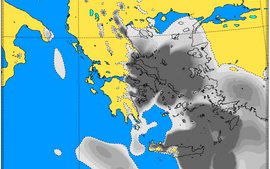Projects » The Skiron System: Parallelization of the ETA model
 The Parallel Skiron System was developed within the framework of a project funded by the E.C. with main objective the development of a high accuracy weather prediction system on high performance platforms. The main part of the Skiron System is based on the ETA model. PSCL undertook and completed the parallelization of the numerical weather forecasting model Eta making PSCL a pioneer in the parallel numerical modeling arena.
The Parallel Skiron System was developed within the framework of a project funded by the E.C. with main objective the development of a high accuracy weather prediction system on high performance platforms. The main part of the Skiron System is based on the ETA model. PSCL undertook and completed the parallelization of the numerical weather forecasting model Eta making PSCL a pioneer in the parallel numerical modeling arena.
The final product is currently in operational use at the Hellenic National Meteorological Service.
Documentation regarding the parallelization of the Eta model is available for download.
The problem
Since the 1940s, dramatic improvements have been made in numerical methods and algorithms, computer technology and architecture, as well as in formulating the fundamental physical processes involved in meteorology and climatology. However, due to the demand for high-resolution and inclusion of complex physical processes in order to make accurate predictions for future climate conditions, the simulation of the Earth's global climate dynamics still remains one of the "grand challenge" problems in high performance computing. The main reason is the fact that the domain of numerical simulations can range over several orders of magnitude both in space and in time. It is estimated that a hundred to a thousandfold increase in computing, communication and data management capabilities will be needed before such goals can be met. An answer to this problem was given in the last decade by the development of massively parallel processor (MPP) systems. Today, many of the largest MPP installations in the world are dedicated weather forecasting centers.
The Parallel Approach
For the parallelization of the Skiron System three parallel interfaces where used: PVM, MPI and PARIX. Parallelism was introduced via domain decomposition techniques and message passing schemes organized in a library of callable routines. The final parallel code has been kept as close to the sequential code as possible and combines portability, scalability and high performance.
More details are available in the following presentation "The Regional Weather Forecasting System Skiron: Parallel Implementation of the Eta Model".
The Parallel Skiron System has been tested and validated on the following platforms:
- HP Exemplar Spp 2000 with 64 processors
- HP Exemplar Spp 1600 with 16 processors
- HP Metaseries Cluster with 8 processors
- Parsytec CCe with 16 processors
- Parsytec GCel 3/512 with 512 processors
The Solution
In order to take advantage of parallel computing in the atmosphere modelling arena, we proceeded to port existing state of the art atmospheric models to MPP platforms. Such a model is the Eta model, developed by NCEP. The parallel Eta model is the main part of the Skiron System.
Acknowlegments
We are grateful to N.Argyropoulos, D.Dimitrelos, D.Nikolaidis, K.Moutselos, T.Papadopoulog, S.Nickovic and G.Kounias for their work on various aspects of the parallel model. We also acknowledge the US National Center for Atmospheric Research (NCAR) which is sponsored by the National Foundation for making available to us the Convex SPP-2000 machine and T.Black (NCEP) for providing us with the sequential version of the Eta code. Finally, we would like to acknowledge G.Kallos for involving us into the project.
Back to top